Sintra-Portugal.com
The best independent guide to Sintra
Sintra-Portugal.com
The best independent guide to Sintra
Sintra; the best sights, attractions and things to see and do in 2025
The picturesque town of Sintra captures the imagination like nowhere else in Portugal. From mist-veiled forests to windswept cliffs, Sintra summons a sense of wild Romanticism, matched only by the flamboyant architecture found throughout the town.
The town revels in its 19th-century Romanticist heritage, with opulent palaces and wondrous villas flaunting whimsical and theatrical design elements. The most famous is the colourful Palacio de Pena, but equally fascinating are the Arabian-inspired Palácio de Monserrate and the mystical gardens of the Quinta da Regaleira.
Venturing beyond the well-trodden tourist trails reveals an alternative side of Sintra, one with dense forests, rugged coastlines, secluded religious sites, and wondrous viewpoints—all awaiting exploration by intrepid travellers.
Sintra is the most popular day trip from Lisbon, but such a fleeting visit barely scratches the surface. To truly immerse yourself in the magic of Sintra, a longer stay is essential. This guide unveils the best sights and activities, helping you to get the most from your day trip or holiday here.
Related articles: Sintra introduction – Day trip to Sintra
The best sights and attractions of Sintra
Sintra is packed with fascinating sights, stunning scenery and exciting activities. The top 10 sights of the Sintra area are:
1) Palácio da Pena 2) Quinta da Regaleira 3) Castelo dos Mouros 4) Palácio de Monserrate 5) Palácio Nacional de Sintra 6) Convento dos Capuchos 7) Cabo da Roca 8) Palácio de Queluz 9) Sintra Tram 10) Capela da Peninha viewpoint
The interactive map below shows the locations of all of these sights. The green markers show the sights of Sintra, while the blue markers are the sights of the surrounding region. (Note: Zoom out to see all of the points)
Sights of Sintra: 1) Palacio da Pena 2) Quinta da Regaleira 3) Castelo dos Mouros 4) Palácio de Monserrate 5) Palácio Nacional de Sintra 6) Sintra Tram 7) Palácio Biester 8) Palácio de Seteais 9) Vila Sassetti 10) Quinta da Ribafria 11) Chalet da Condessa d'Edla 12) Parque da Liberdade 13) Caminho de Santa María Hike 14) Queijadas da Sapa 15) Museu Anjos Teixeira 16) Museu de História Natural de Sintra
Sights of Sintra region: 17) Cabo da Roca 18) Palácio de Queluz 19) Convento dos Capuchos 20) Capela da Peninha viewpoint 21) Praia das Maçãs (beach and town) 22) Praia do Guincho (beach popular for kite-surfing) 23) Praia da Ursa (beach) 24) Praia Grande (Surfing beach) 25) N247 (scenic road) 26) Cascais 27) Estoril
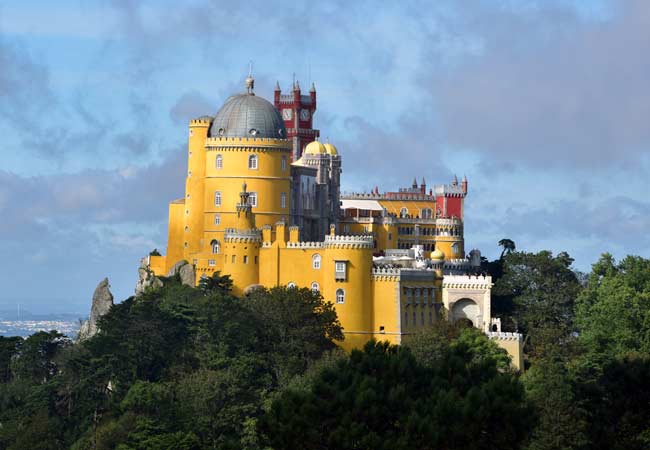
The beautiful Palácio Nacional da Pena is always a highlight of a day trip to Sintra
A typical day trip to Sintra will take in the Quinta da Regaleira or the Palácio Nacional de Sintra, with lunch in the historic town centre. The afternoon rides the 434 bus up the hill to visit the Palacio da Pena and Castelo dos Mouros (if time allows).
The Palacio da Pena is the highlight of the day, but it can get extremely busy. It is advisable to visit Sintra as early in the day as possible to avoid the worst of the crowds.
For a less touristy and more relaxed day trip, consider visiting the Palácio de Monserrate, the Palácio Biester (if time allows) and the gardens of the Palácio de Seteais. After lunch in the historic centre of Sintra, you can visit the Quinta da Regaleira or Palácio Nacional de Sintra. The Palácio de Monserrate and the mystical gardens of the Quinta da Regaleira will be the highlights of this day trip.
If you are lucky enough to be planning a longer trip to Sintra, a recommended itinerary is:
• Day 1) Palacio da Pena (early as possible), Parque da Pena and Castelo dos Mouros, then walk into town via the scenic Caminho de Santa María footpath.
• Day 2) Palácio de Monserrate, Palácio de Seteais (gardens), Palácio Nacional de Sintra (optional) and Quinta da Regaleira (late in the day when the gardens are quieter)
• Day 3) Tram ride to Praia das Maçãs walk to Praia Grande, then head to the Cabo da Roca at sunset. If you have a car, the third day could also include the Convento dos Capuchos, the Capela da Peninha viewpoint and a drive along the stunning N247 road.
Insight: This itinerary assumes you've already stayed in Lisbon (3 days recommended) and you will visit Cascais afterwards (1 day needed)
The remainder of this guide will detail the best sights and attractions of Sintra.
The Palacio da Pena (The Pena Palace)
The exquisite Palacio da Pena is one of the finest tourist attractions of Portugal and is a highlight of any visit to Sintra. This vividly-painted palace was commissioned in 1842 by King Ferdinand II, who championed the arts, literature and music. He wished his palace to reflect a scene from an opera - and from this brief, the extravagant Palacio da Pena was constructed.
It boasts a thrilling mix of influences, ranging from North African to Gothic, with carvings of mythical monsters, decorative battlements and a striking colour scheme. The interior is equally fascinating, having been restored to how it was in 1910 when Queen Amélia spent her last night here before fleeing to Brazil at the start of the Portuguese revolution.
Surrounding the palace is the Parque Pena, a series of forests and gardens that resonated with the ideals of the 19th-century Romanticism movement. There are picturesque footpaths, wonderful viewpoints (such as Cruz Alto, peak 529m) and hidden features including the warrior statue, the lakes and the Chalet da Condessa d'Edla.
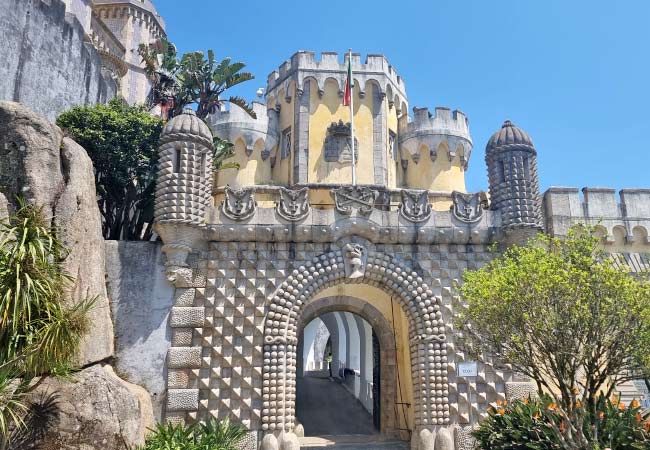
The decorative entrance to the Pena Palace
Tourist information: Due to its popularity, visits to the palace are via a timed ticket, which provides a 30-minute time window to enter the main building of the palace. During the peak season, the most popular time slots are booked, and it is advisable to book tickets at least the day before. Tickets can be purchased from Getyourguide.com for €20 - click here.
There is a cheaper ticket (€10) that provides entrance to the gardens and forests that surround the Palácio da Pena, but not the actual palace. Surprisingly very little of the palace can be seen from the grounds, and the cheaper ‘Park Only’ ticket is not recommended if this is your first visit.
Related articles: The Palacio da Pena
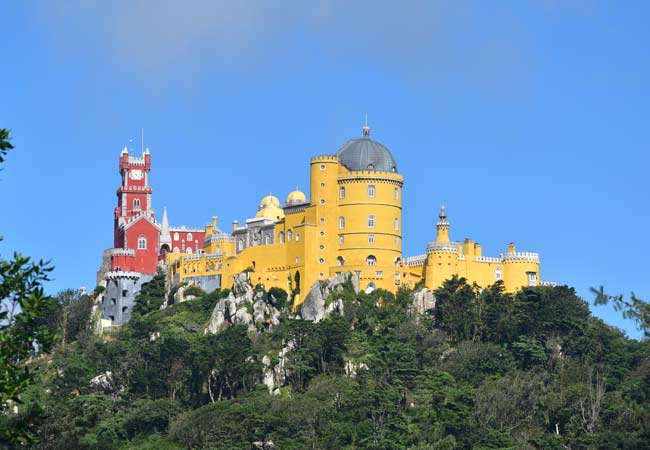
The beautiful Pena Palace as seen from the Alto do Cha viewpoint
The Quinta da Regaleira
The Quinta da Regaleira is a unique historical estate located near the center of Sintra, that dates back to the early 20th century. Originally built between 1904-1910 for owner António Augusto Carvalho Monteiro, this luxurious property and its expansive gardens seamlessly blend Gothic towers, Roman statues and other whimsical architectural elements into one magical landscape.
Hidden within the gardens is the Poço Iniciáticoin (initiation well), an impressive 27-meter deep initiation well connecting to a series of underground tunnels, that symbolises Carvalho connections to the ancient Templar Knights and aspects of Alchemy and Masonic traditions.
The Quinta da Regaleira gardens are a joy to explore on a hot summer's day, and it is the second-best attraction in Sintra after the Palacio da Pena.
Tourist information: The gardens can get busy between 10am and 3pm, and the allure of the initiation well and connecting caves can be lost if packed. Plan to visit early or later in the day.
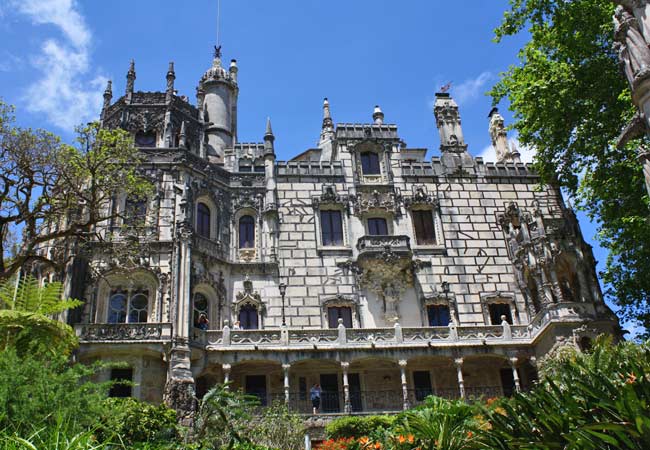
The Quinta da Regaleira
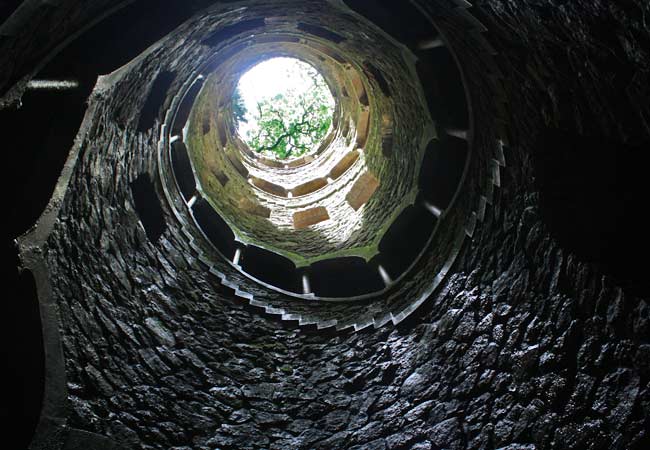
The Initiation Wells (Poço Iniciáticoin) in the Quinta da Regaleira
How about a small group tour?
An organised tour is a hassle-free way to explore Sintra - and the only sensible option if you want to see both Sintra and Cascais in a single day. We have worked with GetYourGuide for the previous seven years, and some of their highest-rated tours of Sintra include:
• Sintra Highlights Full-Day Tour (€65)
• Sintra, Cabo da Roca and Cascais Full-Day Tour from Lisbon (€63)
• Pena Palace and Regaleira Guided Tour from Lisbon (€65)
• Sintra, Cascais and Cabo da Roca Coast Day Tour (€85)
The Convento dos Capuchos
The Convento dos Capuchos is a humble Franciscan monastery that is intertwined with the dense forests of the Serra da Sintra.
This austere 17th-century monastery exemplifies the Franciscan belief that humans should not impact on nature, and the entire complex exists in harmony with its natural surroundings.
Its simplistic stone buildings are surrounded by the ancient forests, while the main chapel is hidden in a cave formed by the region's massive boulders. The only compromise for the monks’ reflective and devout lives was the use of cork as a natural insulation against the harsh winter conditions.
Today, the Capuchos Convent has been completely taken over by the forest, and this unassuming convent is one of the most fascinating attractions of Sintra - as well as being one of the least visited.
Related articles: The Convento dos Capuchos
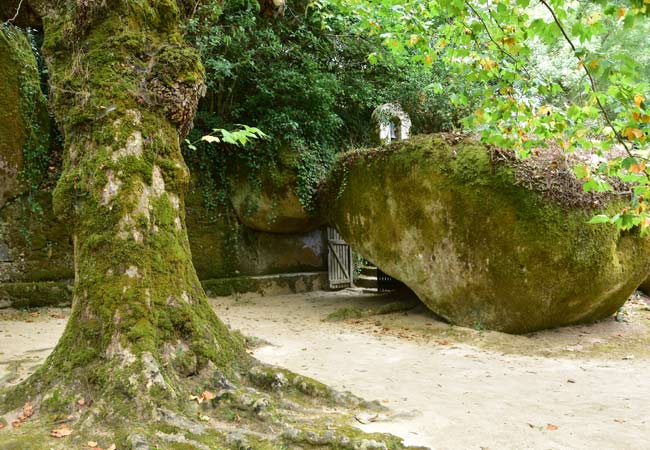
Massive boulders and ancient trees of the Convento dos Capuchos
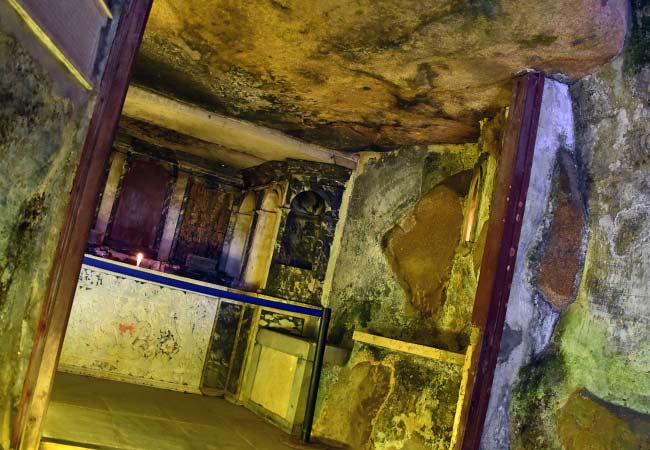
The chapel beneath the huge boulder
The Palácio Nacional de Sintra
The Gothic-style Palácio Nacional de Sintra is situated in the centre of the town, with two impressive coned chimneys rising from its kitchens.
This was Portugal's most used royal palace, being in continual use from the 15th century up until the fall of the monarchy in 1910. This is the palace where King Afonso VI (1650s) was imprisoned after his brother deemed him too unstable to rule the country.
The exterior of the palace is dominated by its huge chimneys, while the interior includes decoratively-painted rooms that reflect the extensive history of the palace. The most famous of these is the Magpie Room, which has paintings of magpies representing the gossiping and scheming of the Queen's ladies-in-waiting.
Insight: For your day trip to Sintra, the Palácio Nacional and Quinta da Regaleira provide two very different options while in the historic centre. The Palácio Nacional is better suited if you're into history and more classical buildings, while the Quinta da Regaleira gardens are more exciting and unique.
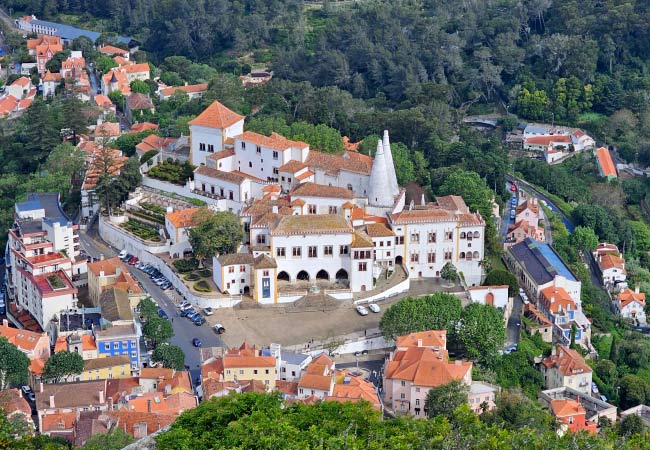
The Gothic exterior of the Palacio Nacional Sintra
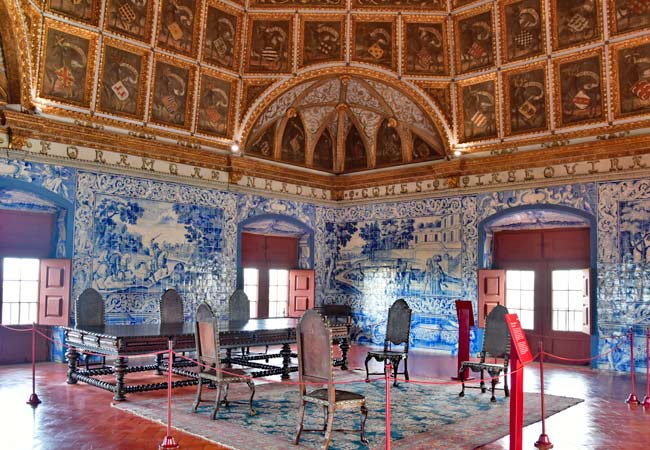
The Sala dos Brasões in the Palacio Nacional
The Castle of the Moors (Castelo dos Mouros)
Perched dramatically atop a towering crag overlooking Sintra stands the ancient Castelo dos Mouros.
Dating from the 9th century, this formidable hilltop citadel was constructed not just for defense, but also as a strategic vantage point, allowing the North African Moors who ruled the region clear views over the entire coastline and surrounding lands.
The castle was extensively restored during the construction of the Palacio da Pena in the 19th century, and today it is one of the best attractions of Sintra. From the battlements are spectacular views over the region, and it is one of the largest castles in Portugal.
Insight: The Palacio da Pena and its grounds should be visited before the Castelo dos Mouros, unless there are ridiculously long queues to enter the Pena Palace.
Related articles: The Castelo dos Mouros
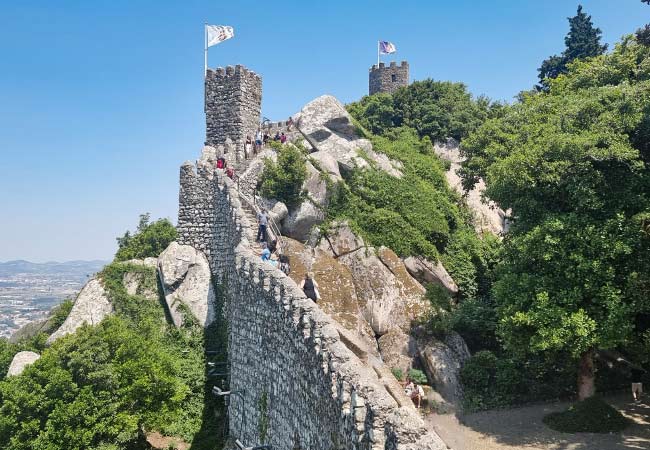
The Moors castle stands high above Sintra
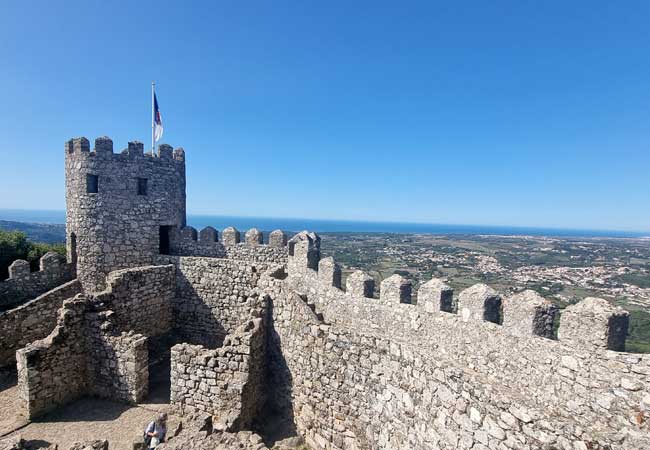
The view from the battlements are wonderful on a clear day
Palácio de Monserrate - Sightseeing in Sintra
The beautiful Palácio de Monserrate is a hidden gem of the Sintra region, which is sadly overlooked by most tourists.
This grand villa has beauty in its small details; from the intricate geometrical patterns of the lattice carving, to the fine stone details on the exterior and intricate Asian-inspired stone inlaying.
The Palácio de Monserrate was constructed by Francis Cook, a merchant who amassed a fortune exporting textiles and wool - and who was at one point Britain's richest man. The gardens are quintessentially British, with an immaculate lawn and beautiful rose gardens.
Monserrate is the perfect place to visit in summer when the crowds at the other attractions become unbearable.
Related articles: The Palacio de Monserrate
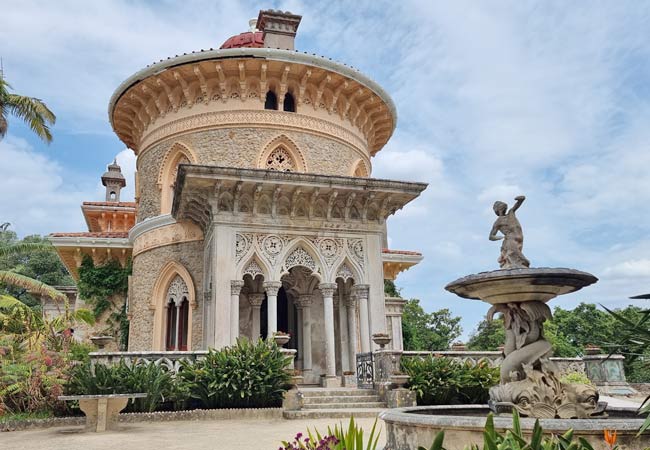
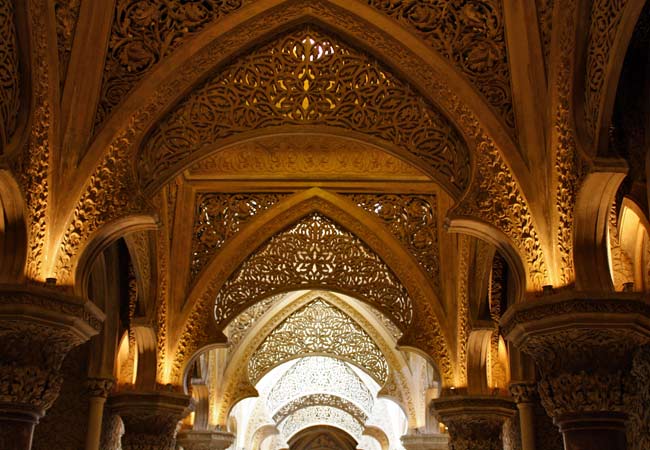
The beautiful stone carvings inside Monserrate
The Palácio de Seteais
The Palácio de Seteais is a magnificent neo-classical palace that dates from 1783. The palace today is a luxurious hotel, but non-guests are able to visit the grounds. The grounds include a terrace garden with amazing views, hedge mazes and an impressive triumphal archway.
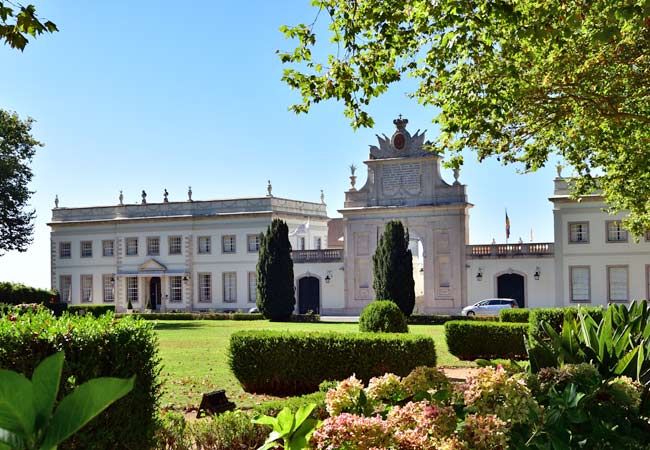
The Cabo da Roca
The Cabo da Roca is the most westerly point of mainland Europe, and is a baren windswept coastline of towering cliffs and powerful Atlantic waves. This is a region to appreciate nature’s raw beauty.
Perched at the top of the cliffs is a powerful lighthouse, while leading from the headland are scenic coastal footpaths – the beautiful Praia da Ursa is only 1.3km to the north. At sunset, the Cabo da Roca is a magical location to watch the sun drop below the vast ocean.
Related articles: Cabo da Roca guide
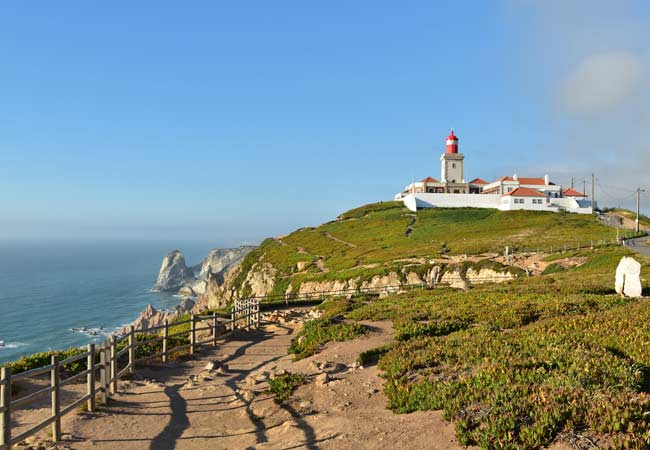
The Cabo da Roca with the powerful lighthouse to the rear
Fábrica das Verdadeiras Queijadas da Sapa
Every Portuguese town has its own traditional sweet pastry, and the delicious speciality of Sintra are Queijadas (Queijadas de Sintra). These crispy, pastry tarts are filled with a sweet mix of cheese, eggs, milk and sugar – and are the perfect treat during a long day of sightseeing!
Queijadas have been made in Sintra since the medieval period, but it was Maria Sapa in 1756 who first started to prepare them commercially. Her recipe was passed down through the generations, and the family shop - the Fábrica das Verdadeiras Queijadas da Sapa - is the best place to try them.
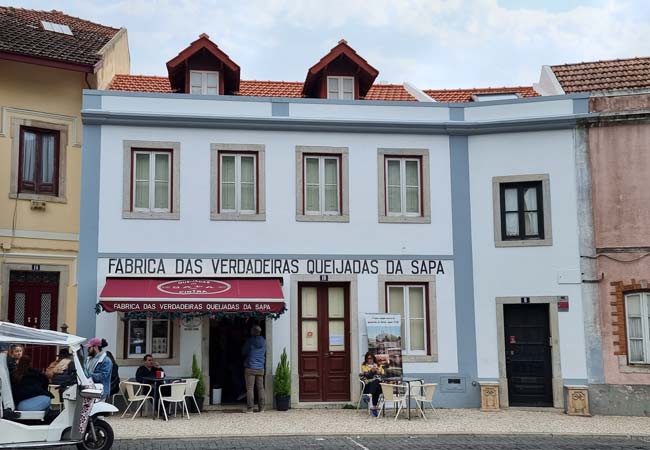
The Praia das Maçãs and the Sintra Tram
The charming coastal town of Praia das Maçãs is the location of the best beach which is easily accessible from Sintra (the beach is also called Praia das Maçãs). Connecting Sintra to Praia das Maçãs is a delightful tram, which trundles along the 13km route. Praia das Maçãs and the Sintra Tram is one of the best day trips if you’re on holiday to Sintra.
Insight: Just to the south of Praia das Maçãs (and walkable) is the popular surfing beach of Praia Grande
Related articles: Guide to Praia das Maçãs
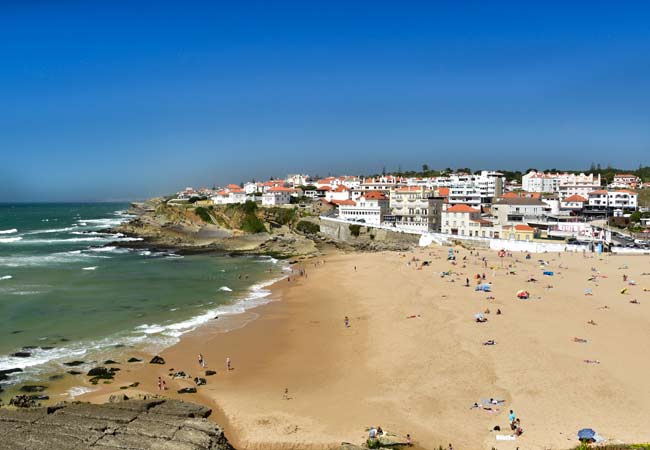
The Praia das Maçãs is a fantastic beach
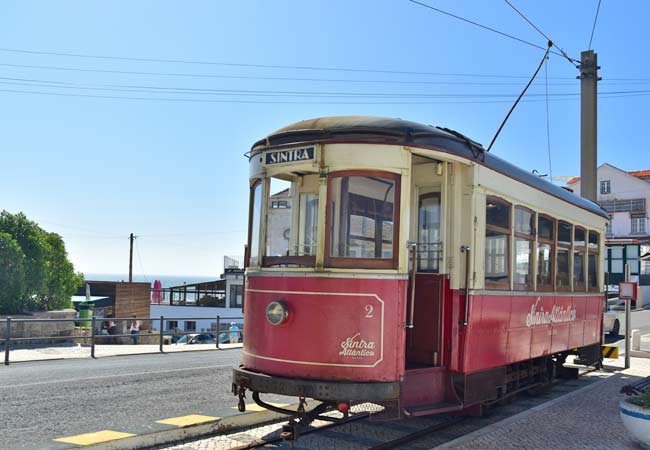
The delightful tram connecting Sintra to Praia das Maçãs
Capela de Nossa Senhora da Peninha
The Peninha chapel stands atop a rocky outcrop on the western side of the Serra da Sintra and provides one of the finest views of the region. The chapel can only be reached by car, but a trip here could be combined with the scenic drive along the N247 road.
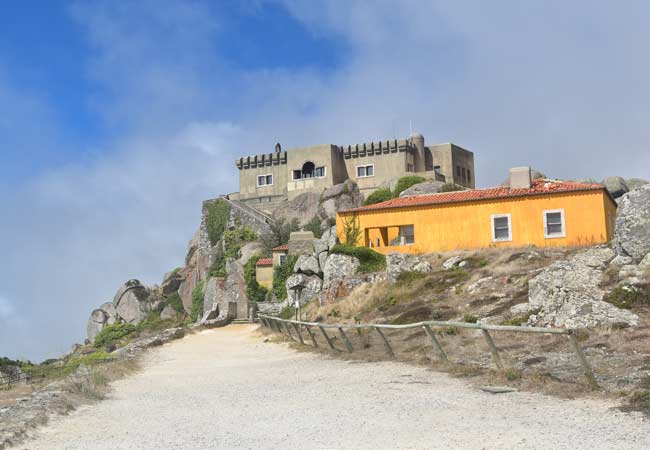
The Santuario da Peninha
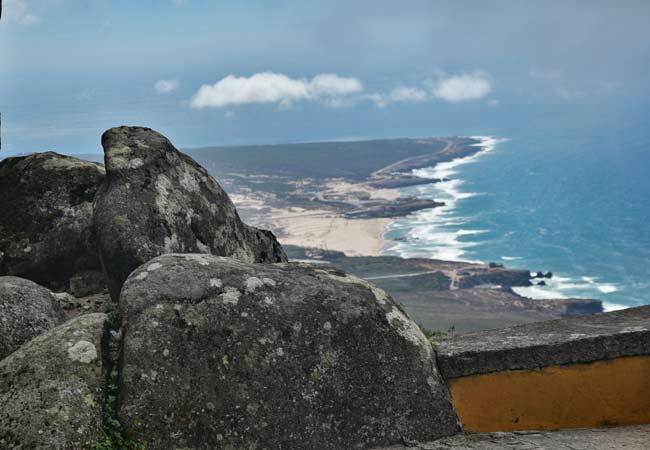
The view over the Sintra coastline from Peninha
Palácio de Queluz
The Palácio de Queluz is a magnificent Rococo-styled palace that offers majestic 18th-century staterooms and wonderful gardens.
This lavish palace was built during the era when Portugal discovered gold in Brazil and the nobility constructed extravagant palaces, for which Queluz is regarded as the finest. Queluz lies partway between Lisbon and Sintra, but can easily be reached by train.
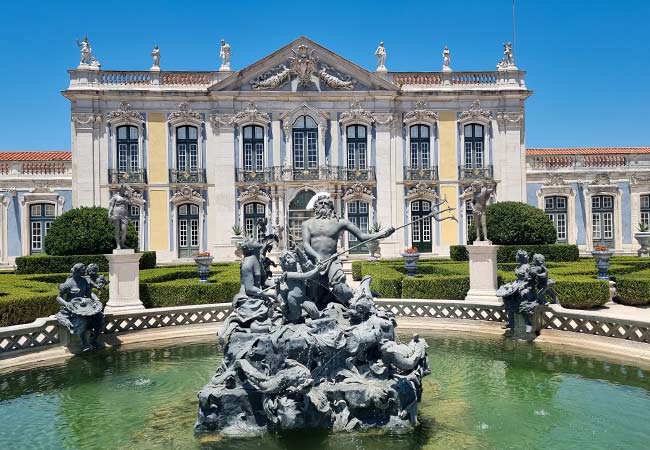
The highlight of the Palácio de Queluz are the gardens and exterior of the palace
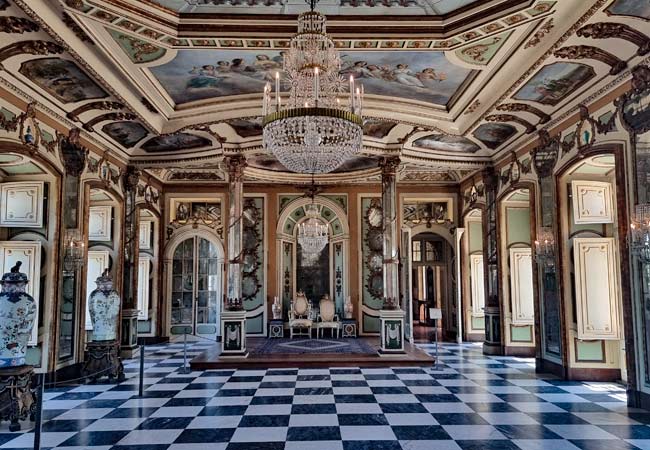
The Sala dos Embaixadores (Ambassadors Room)
Câmara Municipal de Sintra
The Câmara Municipal de Sintra (Sintra town hall) is one of the finest examples of the whimsical Romanticist style of architecture found in Sintra. The building was completed in 1909 and boasts a decorative Manueline-inspired entrance and a flamboyant clock tower. Sadly, the interior of the building is not open to the public, but the exterior is free to see.
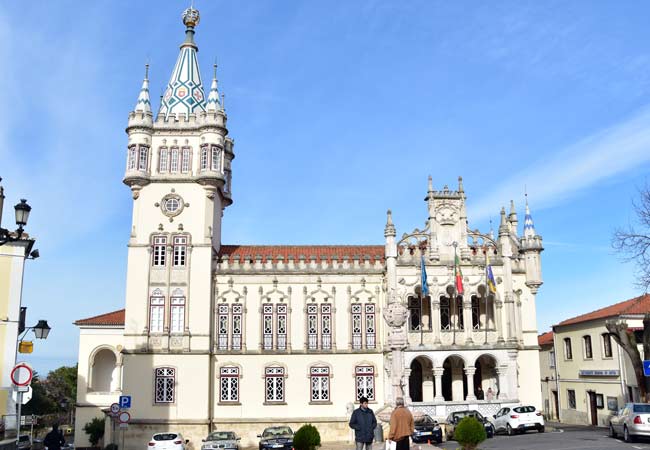
The Praia da Ursa
The Praia da Ursa is one of the most spectacular beaches of the Sintra coastline, and the location to escape the tourist masses. This remote beach sits at the base of a steep cliff, and is reached via dirt tracks and a footpath that scrambles down the side of the collapsed cliff.
The Praia da Ursa is distinctive for its two huge rocky outcrops; sections of harder cliffs which have withstood the power of the Atlantic Ocean. These rocky islands give the beach its name as the ‘Rocha da Ursa’ supposedly looks like a bear (ursa in Portuguese)
Insight: There is a very scenic 1.7km coastal path from the Cabo da Roca to the Praia da Ursa, and this path is the suggestion to extend a visit to the Cabo da Roca.
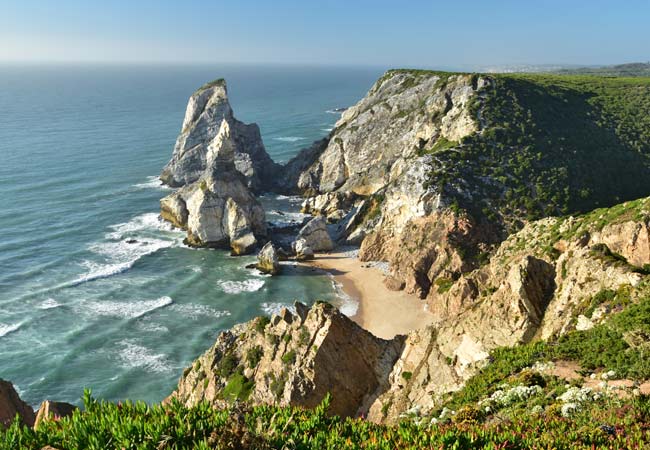
The Praia da Ursa is a picturesque beach that faces the powerful Atlantic Ocean.
The N247 road
If you have a car, the N247 road between Azóia and Cascais provides one of the most spectacular driving routes of the Lisbon region. The road twists and turns through the Serra da Sintra hills and provides fantastic views over the region, before descending down into the pretty town of Cascais.
Related articles: The best driving routes in the Lisbon region
If you've found our content valuable, we'd welcome your support.
The digital publishing landscape has evolved significantly. As a small independent publisher, we face growing challenges. Search engines increasingly favour paid content over organic results, while AI-generated content often reproduces original work without attribution.
To support our work, please consider bookmarking this page (press Ctrl + D) for quick access. If you find an article helpful, we'd be grateful if you'd share it with friends on social media.
For specific questions, please see our Reddit community at r/LisbonPortugalTravel.
Should you notice any outdated or incorrect information, please contact us at [email protected]
Thank you for helping us continue to provide valuable content in an increasingly challenging digital environment.
A complete list of all of our Sintra and Lisbon guides
If you've found our content valuable, we'd welcome your support.
The digital publishing landscape has evolved significantly. As a small independent publisher, we face growing challenges. Search engines increasingly favour paid content over organic results, while AI-generated content often reproduces original work without attribution.
To support our work, please consider bookmarking this page (press Ctrl + D) for quick access. If you find an article helpful, we'd be grateful if you'd share it with friends on social media.
For specific questions, please see our Reddit community at r/LisbonPortugalTravel.
Should you notice any outdated or incorrect information, please contact us at [email protected]
Thank you for helping us continue to provide valuable content in an increasingly challenging digital environment.































